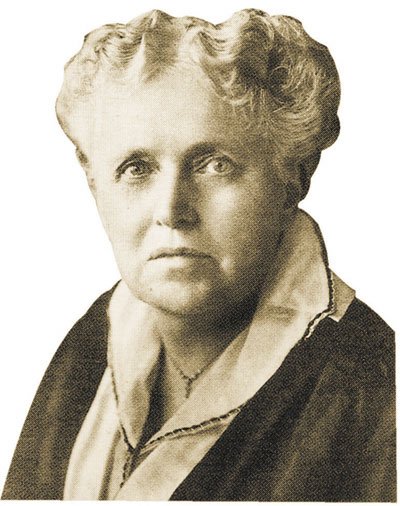It’s easy to take it for granted now
– the sheer numbers of women in the work force, earning bigger
paychecks, wielding more power. The freedom to choose whether to
have families or careers – or both. But it had to start somewhere,
with someone special.
It’s easy to take it for granted now – the sheer numbers of women in the work force, earning bigger paychecks, wielding more power. The freedom to choose whether to have families or careers – or both. But it had to start somewhere, with someone special. These women, for instance. Constrained by fears, stereotypes and, in one case, chains, they did the hard work, forcing open the doors for those who followed.
Grace Hopper, inventor
Put aside the picture of computer whizzes as impossibly young geeks with glasses. Instead, think “grandmother.” Hopper played that role in the infancy of the computer age with her groundbreaking work, including programming the world’s first large-scale computer.
Born in 1906 in New York City, Hopper learned math by helping her surveyor grandfather. In 1928, she earned a bachelor’s degree from Vassar College in math and physics; a master’s and doctorate in math from Yale would follow. She taught both subjects at Vassar for 12 years. During World War II, she joined the Naval Reserves, where she coined the term “debugging” after finding a moth stuck in a computer. In 1952, she invented the compiler, which automated common computer instructions. She was the first to write programs in English and helped developed COBOL, the first user-friendly programming language, still in use today. She returned to active duty in 1967 to revamp the Navy’s computer system, and in 1985 was named rear admiral. She was the first woman awarded the National Medal of Technology, and the first person given Computer Sciences “Man of the Year” award. She retired as the oldest military officer on active duty and consulted for Digital computer company until her death in 1992. Five years later, the Navy commissioned a destroyer the USS Hopper.
Ida Lupino, director/producer
Movie buffs may remember Lupino as the “hard-luck dame” in a string of eight Warner Bros. films in the 1930s and ’40s. While her acting skills earned her the New York Critic’s Best Actress Award in 1942, her real influence was felt behind the camera.
She was born in London in 1918 to one of Britain’s oldest theatrical families and made her first movie at the age of 14. In 1934, she came to Hollywood to critical success. But, dissatisfied as an actress, she co-founded a production company in 1949. She became the only female director of major films, whose plots generally focused on the problems women faced. In the late ’50s, she starred with her husband, Howard Duff, in the TV sitcom “Mr. Adams and Eve,” and later directed or produced more than 100 TV episodes, including “Alfred Hitchcock Presents,” “The Twilight Zone” and “Gilligan’s Island.” She also dabbled in dance, music and art. She died in 1995, leaving a legacy of 60 films.
Emma Gillett,
educator
In 1896, Gillet helped found one of the first law schools open to women, now a part of American University in Washington.
Gillett graduated from Lake Erie (Pa.) Seminary in 1870 and taught for 10 years. She moved to Washington to study law, but found the doors of white law schools closed to her. She found a home at a respected black college, Howard University Law School, and was admitted to the bar in 1883. Thirteen years later, Gillett and Ellen Mussey joined forces and began law classes for women in Mussey’s office, in what was to become the co-ed Washington College of Law. Gillett died in 1927, and Mussey went on to fight for property and child-custody rights for women until her death in 1936.
Ray Eames, designer
Eames, along with her husband and partner, Charles, revolutionized post-World War II design and architecture.
Born in Sacramento in 1912, she attended private school in New York City. She studied painting with abstract expressionist Hans Hofmann and dance with Martha Graham. In 1940 she met architect and designer Charles while studying at Cranbook Academy of Art near Detroit. Although they enjoyed a bohemian lifestyle, they had a more commercial path in mind. Two years later, from their home in Los Angeles, they started designing furniture that combined mass production with style and comfort. The molded plywood Eames chair is world famous; their designs are used in airports and schools. In 1949, the couple designed and built their home to promote the use of low-cost standardized parts and industrial material. She died in 1988, 10 years to the day of her husband’s death.
Mary Breckinridge, nurse/medical reformer
Raised in a life of privilege, Breckinridge saw a crying need for health care for poor women in remote rural areas, and she filled it, assuring safer childbirths for thousands of Appalachian mothers and their babies.
Breckinridge was born in 1881 in Memphis, Tenn. At 13, she spent two years in Russia after her father was appointed presidential representative to the Court of Czar Nicholas II. She became a widow at age 26, and divorced her second husband after her two children died before the age of 5. It was then that she became a registered nurse and a certified midwife. When she moved to eastern Kentucky, she found few doctors and a high infant-mortality rate. In 1925 she established the Committee for Mothers and Babies, later called the Frontier Nursing Service. Breckinridge found ways to get around the rural isolation and poverty – she rode on horseback to visit her patients and accepted barter for payment. As the infant death rate fell, her techniques became a model for doctors. She used her fame to raise money for a school for midwifery, and edited a medical journal for 40 years. She died in 1965; her image appeared on a U.S. postal stamp in November 1998.
Phyllis Wheatley, author
In 1760, 7-year-old Wheatley was brought from West Africa to colonial Boston in a slave ship. She turned her tragedy into poetry, becoming the first known African American to publish a book.
She started her life in Boston as a slave to the wealthy Wheatley family. The Wheatleys’ daughter took a liking to her and taught her to read English, Latin and Greek. Phyllis wrote her first poem at age 12, and was shown off as an intellectual novelty – George Washington asked to meet her after she wrote a poem about his Revolutionary War exploits. In 1773, she sailed to London, where her first book of poetry was published to great acclaim. When Mrs. Wheatley died, Phyllis returned to Boston and was given her freedom. She failed to raise money for a second book and in 1779 married, hoping for financial security. Instead she died alone in a boarding house in 1784, just before her last poem was published. In 1999, a recently discovered Wheatley poem – written 226 years earlier – had its first reading.
Amelia Bloomer, dress reformer
In the late 1840s, women shoe-horned themselves into restrictive corsets and dresses weighing up to 15 pounds. Enter Bloomer, a figurative breath of fresh air, who shocked the nation by putting women in pants.
Born in Homer, N.Y., in 1818, Bloomer was educated to be a teacher. She married a newspaper editor in 1840 and moved to Seneca Falls, N.Y., a hotbed of women’s rights activity. Nine years later, she started the Lily, the first national women’s newspaper edited by a woman. In 1851, she thrilled women and infuriated men by publishing the pattern for unrestrictive pantaloons, designed by Elizabeth Miller. The delighted press dubbed them “bloomers” and ridiculed her mercilessly, but that didn’t stop her from touring the nation delivering lectures on human rights while dressed in the offending garment. She moved to Iowa in 1853, where she continued her fight for women’s rights. By the time she died in 1894, she had given up wearing bloomers, but by then, there was no going back for grateful womanhood.














